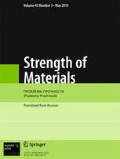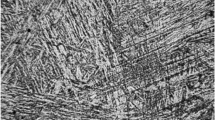The effect of hydrogen at a pressure of up to 35 MPa and a content of up to 29 ppm on the strength, ductility, short-term and long-term static crack resistance of four KhN43MBTYu (EP-915VD) alloy modifications with different heat treatment modes and chemical composition has been studied. It has been found that the critical stress intensity factor KIc in the presence of hydrogen, just as the ductility characteristics of smooth specimens, depends on the deformation rate, reaching minimum values at rates of less than 0.1 mm/min. The fracture toughness decreases under the action of hydrogen by a factor of 2.5, and the plane strain state occurs at a much smaller specimen thickness. An optimal combination of high strength, ductility, short- and long-term static crack resistance in air and hydrogen has been achieved in a fine-grained alloy with low carbon and sulfur content. Based on the results of long-term static crack resistance tests at the predetermined maximum fatigue test duration of 300 h, the invariant characteristics of crack resistance, the threshold values of stress intensity factor in hydrogen, have been determined, which vary from 23 to 48 MPa ∙ m1 / 2 depending on the alloy heat treatment mode.











Similar content being viewed by others
References
J. A. Lee, “Hydrogen embrittlement of nickel, cobalt and iron-based superalloys,” in: R. P. Gangloff and B. P. Somerday (Eds.), Gaseous Hydrogen Embrittlement of Materials in Energy Technologies, Vol. 1: The Problem, Its Characterization and Effects on Particular Alloy Classes, Woodhead Publishing (2012), pp. 624–667.
M. Dadfarnia, A. Nagao, S. Wang, et. al., “Recent advances on hydrogen embrittlement of structural materials,” Int. J. Fracture, 196, 223–243 (2015).
A. M. Syrotyuk and I. M. Dmytrakh, “Methods for the evaluation of fracture and strength of pipeline steels and structures under the action of working media. Part I. Influence of the corrosion factor,” Mater. Sci., 50, No. 3, 324–339 (2014).
A. I. Balitskii and V. V. Panasyuk, “Workability assessment of structural steels of power plant units in hydrogen environments,” Strength Mater., 41, No. 1, 52–57 (2009).
A. M. Syrotyuk and I. M. Dmytrakh, “Methods for the evaluation of fracture and strength of pipeline steels and structures under the action of working media. Part II. Influence of hydrogen-containing media,” Mater. Sci., 50, No. 4, 475–487 (2015).
A. I. Balitskii, V. I. Vytvytskyi, and L. M. Ivaskevich, “The low-cycle fatigue of corrosion-resistant steels in high pressure hydrogen,” Procedia Engineer., 2, No. 1, 2367–2371 (2010).
O. Barrera, D. Bombac, Y. Chen, et al., “Understanding and mitigating hydrogen embrittlement of steels: a review of experimental, modelling and design progress from atomistic to continuum,” J. Mater. Sci., 53, 6251–6290 (2018).
D. M. Symons, “A comparison of internal hydrogen embrittlement and hydrogen environment embrittlement of X-750,” Eng. Fract. Mech., 68, 751–771 (2001).
D. Delafosse, X. Feaugas, I. Aubert, et al., “Hydrogen effects on the plasticity of FCC nickel and austenitic alloys,” in: B. Somerday, P. Sofronis, and R. Jones (Eds.), Effects of Hydrogen on Materials (Proc. of the 2008 Int. Hydrogen Conf., Sept. 7–10, 2008, WY, USA), ASM International, Material Park, OH (2009), pp. 78–87.
A. I. Balitskii and L. M. Ivaskevich, “Assessment of hydrogen embrittlement in high-alloy chromium-nickel steels and alloys in hydrogen at high pressures and temperatures,” Strength Mater., 50, No. 6, 880–887 (2018).
A. Balitskii, L. Ivaskevich, V. Mochulskyi, et al., “Influence of high pressure and high temperature hydrogen on fracture toughness of Ni-containing steels and alloys,” Arch. Mech. Eng., 61, No. 1, 129–138 (2014).
N. A. Sorokina, T. K. Sergeeva, Yu. I. Rusinovich et al., “Hydrogen embrittlement resistance of differently doped nickel alloys,” Fiz.-Khim. Mekh. Mater., 21, No. 1, 27–31 (1985).
C. T. Sims, N. S. Stoloff, and W. C. Hagel (Eds.), Superalloys II, Wiley, New York (1987).
O. I. Balyts’kyi, V. M. Mochyl’skyi, and L. M. Ivas’kevych, “Evaluation of the influence of hydrogen on mechanical characteristics of complexly alloyed nickel alloys,” Mater. Sci., 51, No. 4, 538–547 (2016).
GOST 9651-84. Metals. Methods of Elevated-Temperature Tensile Testing [in Russian], Publishing House of Standards, Moscow (1984).
GOST 25506-85. Methods for the Mechanical Testing of Metals. Determination of Crack Resistance (Fracture Toughness) Characteristics under Static Loading [in Russian], Publishing House of Standards, Moscow (1985).
ASTM E1820-08. Standart Test Method for Measurement of Fracture Toughness, ASTM International, West Conshohocken, PA (2008).
M. O. Speidel and M. V. Hyatt, Stress-Corrosion Cracking of High-Strength Aluminum Alloys, in: M. G. Fontana and R. W. Staehle (Eds.), Advances in Corrosion Science and Technology, Vol. 2, Springer, Boston, MA (1972), pp. 115–335.
O. Z. Student, A. D. Markov, and H. M. Nykyforchyn, “Specific features of the influence of hydrogen on the properties and mechanism of fracture of the metal of welded joints of steam pipelines at thermal power plants,” Mater. Sci., 42, No. 4, 451–460 (2006).
A. Balitskii, V. Vytvytskyii, I. Ivaskevich, and J. Eliasz, “The high- and low-cycle fatigue behavior of Ni-contain steels and Ni-alloys in high pressure hydrogen,” Int. J. Fatigue, 39, 32–37 (2012).
D. Holländer, D. Kulawinski, A. Weidner, et al., “Small-scale specimen testing for fatigue life assessment of service-exposed industrial gas turbine blades,” Int. J. Fatigue, 92, 262–271 (2016).
B. A. Kolachev, Hydrogen Brittleness of Metals [in Russian], Metallurgiya, Moscow (1985).
O. N. Romaniv and G. N. Nikiforchin, Corrosion Fracture Mechanics of Structural Alloys [in Russian], Metallurgiya, Moscow (1986).
I. Dmytrakh, “Corrosion fracture of structural metallic materials: Effect of electrochemical conditions in crack,” Strain. Int. J. Exp. Mech., 47, 427–435 (2011).
W. F. Brown and J. E. Srawley, Plane Strain Crack Toughness Testing of High Strength Metallic Materials, ASTM STP 410, ASTM International, West Conshohocken, PA (1966).
M. H. Stashchuk, “Influence of hydrogen concentration on the stresses in a solid metallic cylinder,” Mater. Sci., 53, No. 6, 823–831 (2018).
P. V. Yasniy, I. B. Okipnyi, P. O. Maruschak, et al., “Crack tip strain localization on mechanics of fracture of heat resistance steel after hydrogenation,” Theor. Appl. Fract. Mech., 63–64, 63–68 (2013).
P. V. Yasniy, I. B. Okipnyi, P. O. Maruschak, et al., “Toughness and failure of heat resistance steel before and after hydrogenation,” Theor. Appl. Fract. Mech., 56, 63–67 (2011).
V. I. Tkachov, L. M. Ivas’kevych, and V. M. Mochul’skyi, “Temperature dependences of the mechanical properties of austenitic and martensitic steels in hydrogen,” Mater. Sci., 43, No. 5, 654–666 (2007).
O. I. Balyts’kyi, L. M. Ivas’kevych, and V. M. Mochul’s’kyi, “Mechanical properties of martensitic steels in gaseous hydrogen,” Strength Mater., 44, No. 1, 64–71 (2012).
O. I. Balyts’kyi and O. O. Krokhmal’nyi, “Pitting corrosion of 12Kh18AG18Sh steel in chloride solutions,” Mater. Sci., 35, No. 3, 389–394 (1999).
Author information
Authors and Affiliations
Corresponding authors
Additional information
Translated from Problemy Prochnosti, No. 3, pp. 61 – 74, May – June, 2020.
Rights and permissions
About this article
Cite this article
Balyts’kyi, O.I., Ivas’kevych, L.M. & Eliasz, J.J. Static Crack Resistance of Heat-Resistant KhN43MBTYu Nickel-Chromium Alloy in Gaseous Hydrogen. Strength Mater 52, 386–397 (2020). https://doi.org/10.1007/s11223-020-00189-4
Received:
Published:
Issue Date:
DOI: https://doi.org/10.1007/s11223-020-00189-4




